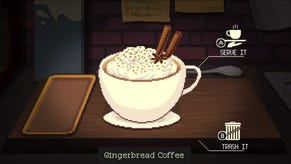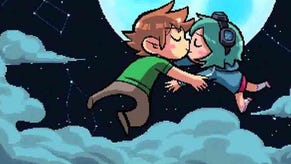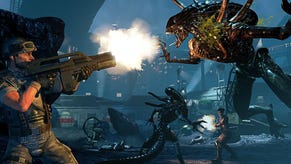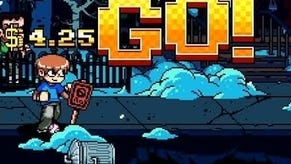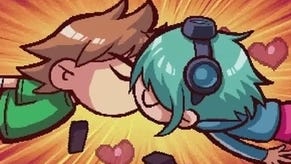Scott Pilgrim vs. The World
The bob-omb?
As well as a health gauge, each character has a set of guts points which can be spent on two types of special moves: one to knock a cluster of surrounding enemies out of the way, and the other to summon a back-up attack from Scott's underage admirer, Knives Chau (17 years old). It's best to use gut points sparingly as, when your health is depleted and you're knocked out, you can use them to regain consciousness, converting gut points into heart points.
The potential to thread attacks together like this with precision timing nudges this low-level aspect to the game slightly in front of closest rival Castle Crashers, but make no mistake: Scott Pilgrim is every bit as straightforward as the Streets of Rage and Teenage Mutant Turtles games it parodies. It's a celebration of the past, not a roadmap to the future.
The structure of the game mirrors that of the series: seven stages, each punctuated by a boss fight with one of Ramona Flowers' seven evil ex-boyfriends. Stages match locations from the books, with occasional diversions through unassuming doorways into sub-space warps from one area to the next, filled with glitches and soundtracked by nostalgic tape loading sounds that will be familiar to all gamers of a certain age.
Enemies drop Canadian dollars and cents when defeated, money which can be used to buy restorative items as well as character-augmenting weaponry, bionic arms and so on. However, the use of bought upgrades is far less involved than in Castle Crashers, and as a result the long-term goals in the game can feel far nearer than in The Behemoth's lengthy proposition.
Each of your characters levels up through 16 levels, a new move or combo unlocked at each threshold. As in most modern scrolling beat-'em-ups that enjoy RPG-lite elements, characters keep their level after the Game Over screen, and can restart the game where they left off, ability-wise.
The difficulty ramps up quickly and, for the solitary player, represents a tall challenge. Played in local multiplayer, where player-characters can juggle enemies between them hurl one another into groups of opponents to launch an Ultimate Band Attack, the difficulty curve becomes far more manageable. For this reason, the lack of online multiplayer is an obvious disappointment.
The Scott Pilgrim franchise is, in one sense, a triumph for those of us who grew up with videogames, the kids whose quiet, nerdish avenue of escapism has somehow became the aesthetic of the hip present. A fanzine-esque comic book turned Hollywood blockbuster, it is our niche shoved onto culture's main stage. It's the geeks inheriting the earth: pixel-art T-shirts in Top Man, chiptune seasoning on Number 1 records, a hundred thousand hipster Tumblr blogs celebrating gaming's minutiae and detritus.
And yet, because the series is a tribute to 20-year-old gaming culture, any actual videogame born from this universe is subject to those restraints. For this reason, Scott Pilgrim vs. The World is pretty much the perfect Scott Pilgrim game, hitting all the notes that fans of the series and its worldview could want. But for those who couldn't tell an Envy Adams from a Julie Powers (pity them), it's little more than a cute parody game, meticulously detailed, but outdated by design.
Scott Pilgrim vs. The World is released on the PlayStation Network next Wednesday, 11th August, as a timed PS3 exclusive. An Xbox 360 version is planned but has no announced release date.

